S
Suzanne Scacca
Guest
If your company has decided to pursue digital coupon marketing, you need to have a plan. These five things can help your brand reap the benefits of coupons while not going broke in the process.
A recent survey revealed that the top reasons consumers try out or switch brands have to do with the cost of goods or services. A reported 65% said they’d switch retailers for lower costs, and 45% said they’d ditch them for coupons and discounts.
It’s not surprising that decision-making is being driven by cost considering the continually high cost of living these days.
While coupons might be seen as cheapening one’s brand identity, it almost seems like a necessity to offer them in today’s economic climate. In the following post, we’ll look at five best practices for coupon marketing that will help you keep your brand’s value and reputation intact while satisfying consumer needs.
Here are some things you can do to reap the benefits and profits from coupon marketing:
According to the Valpak and PureSpectrum survey referenced earlier, there are five methods that consumers prefer most when receiving coupons and offers:
While this gives us a general idea of consumer preferences channel-wise, it’s always a good idea to test coupon marketing efficacy with your target user base. Not only might they have different channel preferences, they might also prefer coupons delivered in formats you hadn’t expected.
Now, back in the day when it was mostly print marketing, coupons mostly looked the same. We’d see a concise offer like “Buy One, Get One” (or BOGO) and then a scannable barcode that would allow us to redeem the coupon.
But digital coupons aren’t restricted to such a strict or simplistic format. Unless your brand has a brick-and-mortar counterpart where barcodes or QR codes need to be scanned, they’re not an essential element to include when designing coupons.
As you craft your coupon offers and come up with a strategy for where to distribute them, you also need to consider what the best way to design them is.
On a website, for example, there are a number of ways to disseminate coupon codes or offers:
While all are equally viable options, what’s most likely to capture your visitors’ attention at that place and time? What’s more, should you follow a similar design approach to what other websites use or experiment with your own?
For example, Lotus and Luna has a pretty traditional coupon pop-up:
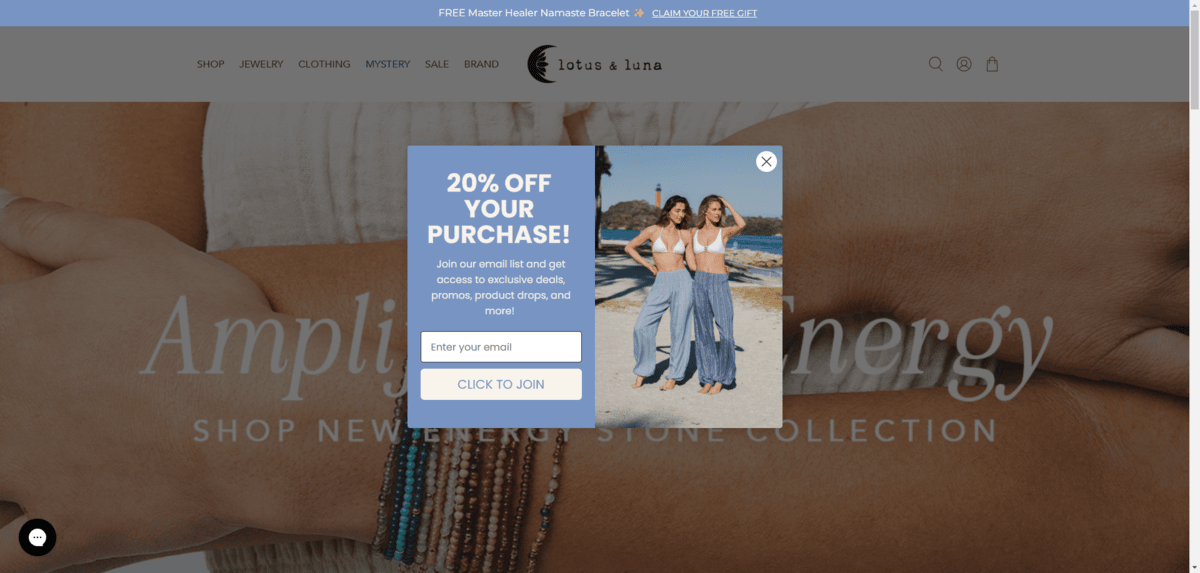
Unlike some pop-ups that make it seem as simple as trading your email for a discount code (which is rarely the case), Lotus and Luna explains that you’re subscribing to a newsletter. This gives you exclusive deals, promos, product drops and other benefits—plus the 20% off the next purchase.
Another approach is a non-traditional one. For instance, Inno Supps has gamified its coupon pop-up.
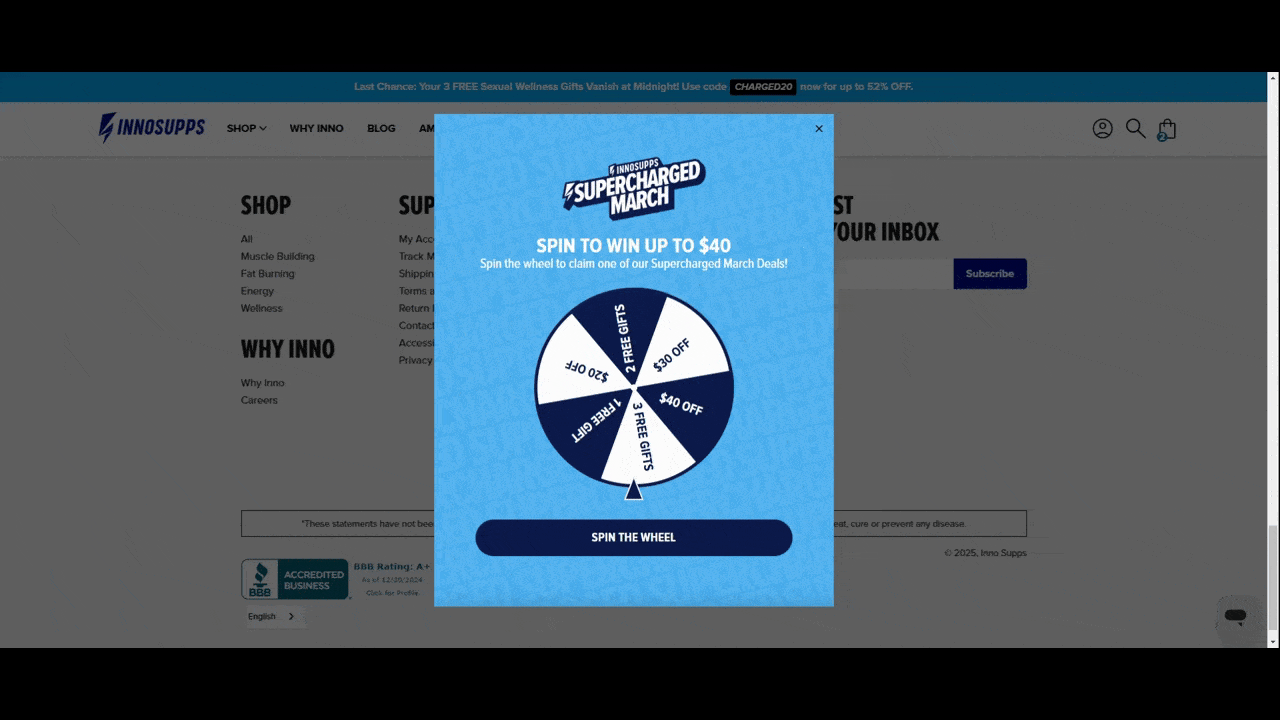
When a visitor enters the website, this “Supercharged March” pop-up appears, inviting them to “Spin to Win Up to $40.” After clicking the button, the animated wheel spins and reveals which of the discounts or free gift offers they get. To claim the offer, the user must enter their email address.
Would your visitors find it fun to take a spin on the wheel of fortune? Or would they appreciate a more predictable approach to coupon marketing?
This is what you need to figure out as you test different offers, placements and channels in your coupon marketing strategy.
Your shoppers are probably thrilled when they find out you’re offering a discount. However, coupon marketing isn’t a no-holds-barred sport. Every brand must set limitations or else they put themselves at risk for exploitation.
So, before you hit the “Publish” button on your new coupon or discount offer, figure out what the terms are first. Ask yourself:
When publishing the terms of the discount, place them close to the coupon code and offer. Ideally, the terms should be spelled out immediately following the coupon code or call-to-action button. They should also be in a font that’s just as large as the offer text so they’re not missed.
Here’s an example from The Fresh Market. This came via email and was sent to Ultimate Loyalty members:
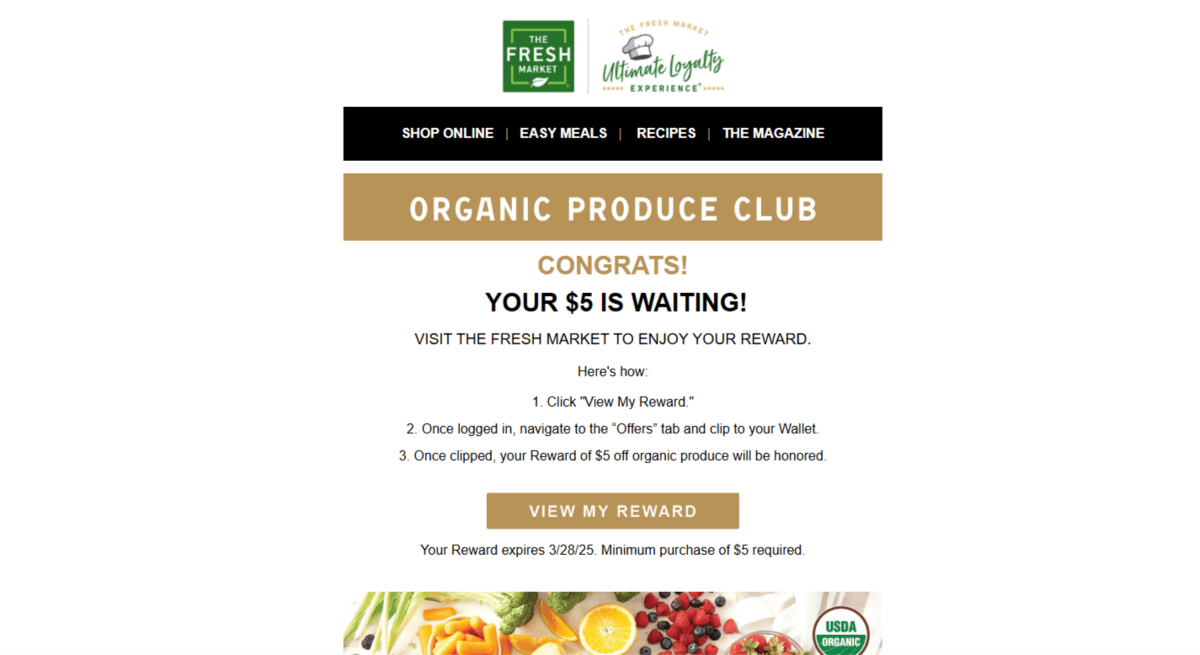
The customer has a $5 voucher to redeem. Beneath the information on how to get $5 off are the terms of the voucher which include:
You can see that there isn’t anything about limiting the number of times the voucher can be used or other terms I mentioned above. In some cases, you don’t need to outline them because you can program your website or app to only accept a coupon or voucher within a certain threshold.
When laying out the terms of the offer, try to keep it as simple as possible so the shopper can focus on their reward. Then, use your CMS to configure the other limits. So long as they’re standard practice (like one-time use), you shouldn’t need to explain it. That said, you may want to add a line about it in your terms of service just to be on the safe side.
You probably don’t want to put yourself in a position where users stumble upon your coupon, try to redeem it and then find out that it’s only for “special” customers. There are also reasons why you might not want to give a discount to just anyone.
For starters, a coupon marketing campaign without limits could make your brand seem desperate. Run enough of them and it could also make your brand’s value seem cheap.
What’s more, coupons cut into your profits and can reduce your return on your investment (ROI).
Let’s say in one scenario that you do no segmentation. You share the coupon on social media and your website, and 500 people use it. Over time, you track that user activity and find that only five consumers have returned to your site to buy something else.
Now, let’s say in another scenario you do segmentation and targeting. You only share the discount over email with newsletter subscribers as well as previous customers. 250 people use it. Over time, 100 of them return to your site to buy some more.
While you may have initially gotten more sales from the first scenario, the long-term ROI is very poor. The second scenario is the ideal outcome because it led to repeat business, even though it didn’t net as many upfront purchases.
How you share your offer and with whom is ultimately up to you and your marketing campaign’s goals. Transactional marketing has its time and place, but relationship marketing has proven time and again to be a more profitable strategy.
Here’s an example of how retailers like BJ’s avoid one-time bargain hunters:
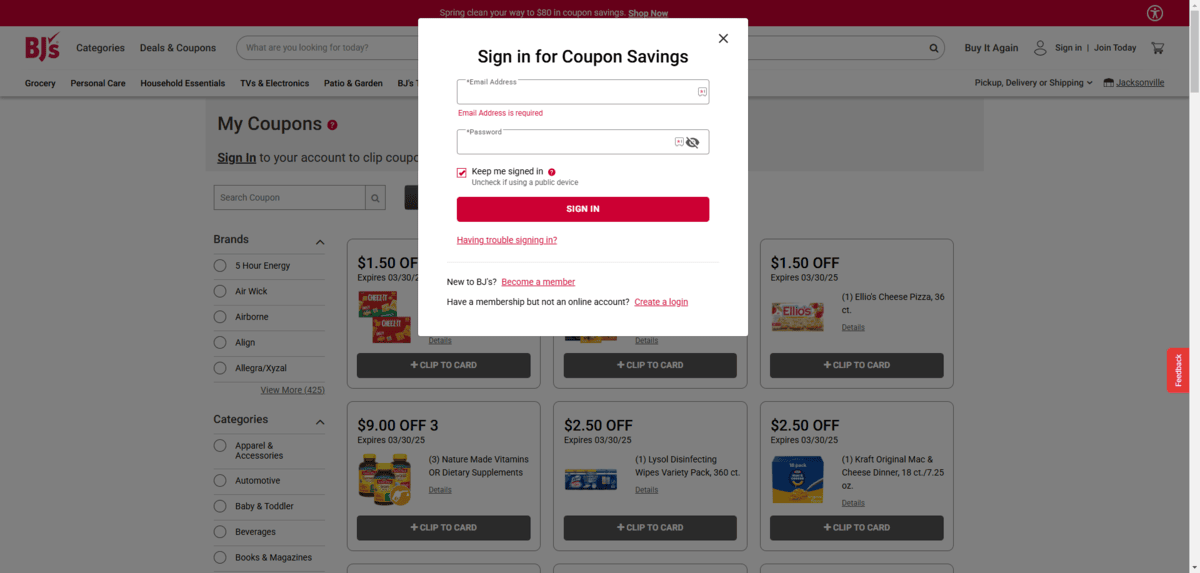
Visitors to the BJ’s website are more than welcome to look around the “Deals & Coupons” section of the site. However, they’re not able to clip any of the coupons unless they have an active membership and account. That’s why this login pop-up gets triggered every time they click one of the buttons.
Once the visitor signs in, though, the page changes as do the inactive “Clip to Card” buttons:
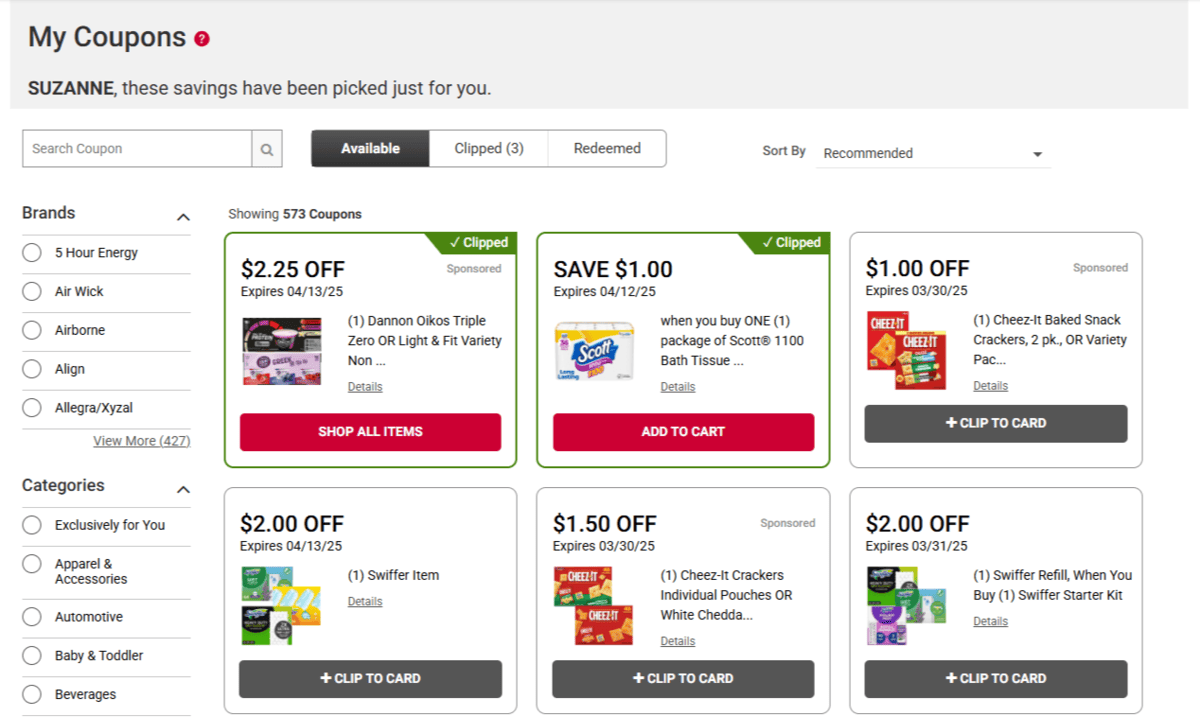
What’s really neat about this coupon clipping experience is how simple and streamlined it is. All users have to do is click “Clip to Card” to add the coupon to their membership card.
If they go to the store and buy the items, the coupons automatically apply to their purchase. If they prefer to shop online, they can immediately add the product to their cart as the “Clip to Card” button converts to a red “Add to Cart” or “Shop All Items” button.
One other thing to mention before I finish this point is segmentation. When segmenting your customers, don’t look at it as who deserves a discount and who doesn’t. You can segment your users and then give each of them custom discounts, delivered through different channels and means.
It’s definitely possible to overdo it with coupons. When consumers come to see your brand as a “discount brand” (and it’s not), it can:
So, coupons should be used sparingly and strategically.
But when and how frequently should you run coupon marketing campaigns? It depends on what kind of business you run.
You could offer coupons and discounts to reward loyal customers at certain points throughout the year. This is an effective strategy as it reminds customers that you’re their go-to source for whatever it is you sell and encourages them to reengage with your brand at regular intervals.
You could also issue coupons to get rid of stock that’s about to be outdated or is nearing the end of its shelf life. By heavily discounting your goods, you’ll appeal to first-time shoppers who may need a bigger push to buy. At the same time, you’ll make way for new inventory that gets customers excited all over again about buying from you.
You can also do coupon marketing seasonally. For instance, if you sell winter gear or summer wear, you could use coupons to push a bunch of new traffic to your store months before.
For example, Soma is doing this right now with its rewards members:
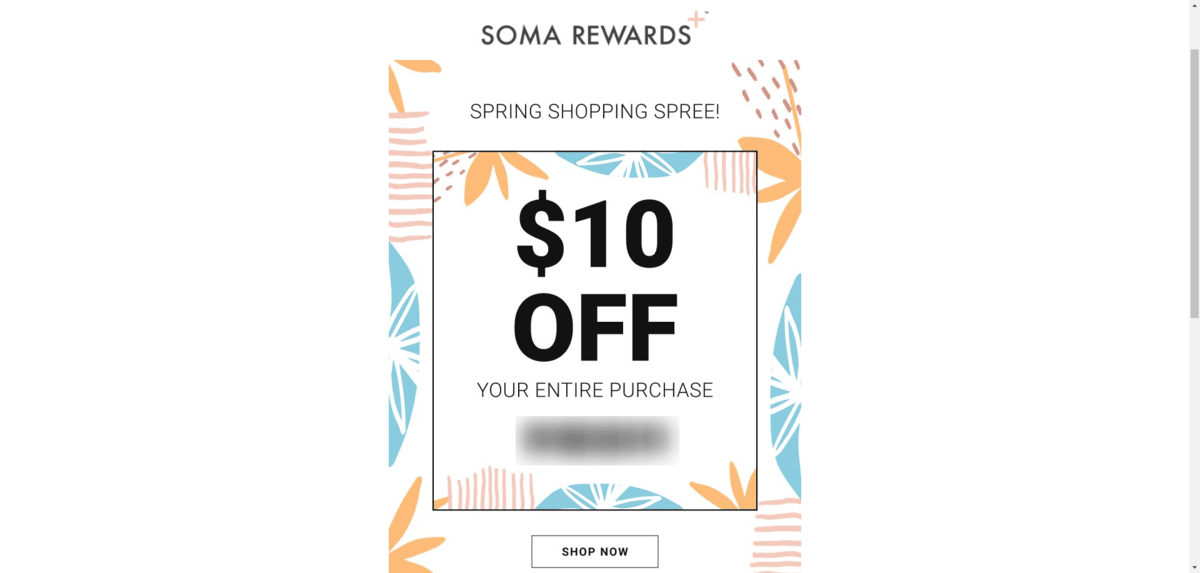
What’s nice about the way this coupon is handled is that it’s a bonus for rewards members.
There’s already a spring sale going on on the website for everyone. But this unique coupon code is sent only to registered Soma members. So, in addition to getting 25% off on their website purchases, they can layer this $10 discount on top of it.
In-store coupon redemption is pretty straightforward. The customer either brings you a digital or printed code to scan or the coupons are automatically deducted from their membership card at checkout.
Digital coupon redemption is a different story. It can be done in many ways. Once you’ve determined what your coupon campaign will entail, you need to map out what this process will look like.
These are the most common ways in which shoppers redeem their coupons:
Regardless of whether your coupons are auto-filled, click-triggered or manually entered, you need to create a seamless redemption process and test it for different scenarios.
For example, let’s start with the basics:
How many steps will shoppers need to take to redeem their coupon? Or, rather, how many steps do you think they’ll be OK with taking?
For instance, you could make this process very brief. Say you have a logged-in user. In the top-right corner of the site, it says they have $10 to redeem on their next purchase. They don’t need to do anything but shop your store, head to checkout and then click “APPLY” to add the coupon to their purchase.
However, let’s say you have a pop-up triggered to appear on your website for first-time visitors. It’s promoting a very attractive offer—40% off a first purchase.
What would serve you best while maximizing how many people claim the discount? Giving them the discount code right then and there? Or asking them for an email address or phone number and then sending them the code?
Providing the code in the pop-up is the more streamlined path and may help maximize sales. But what if it’s like we discussed before and a lot of these purchases end up being a one-time thing? Unless you’re urgently trying to clear out inventory, that might not help you achieve your goals.
Sending the code to email or text may be the better option, in that case. Sure, some visitors will be annoyed they can’t just get the discount. And others might be wary about being spammed. However, this could be an effective way to reengage customers who haven’t bought from you in a while. It can also be a good way to weed out bargain hunters and to demonstrate to people with genuine interest how great your goods and customer service are.
Next, you need to make sure that the coupon redemption process is straightforward. Ask yourself, will the user understand what needs to be done to claim their discount? And, if there’s a coupon field at checkout, is it easy to find and interact with?
In addition, look at the technical aspects of the process. For instance:
The coupon redemption process on the Sephora website is a good example of a well-thought-out coupon redemption flow:
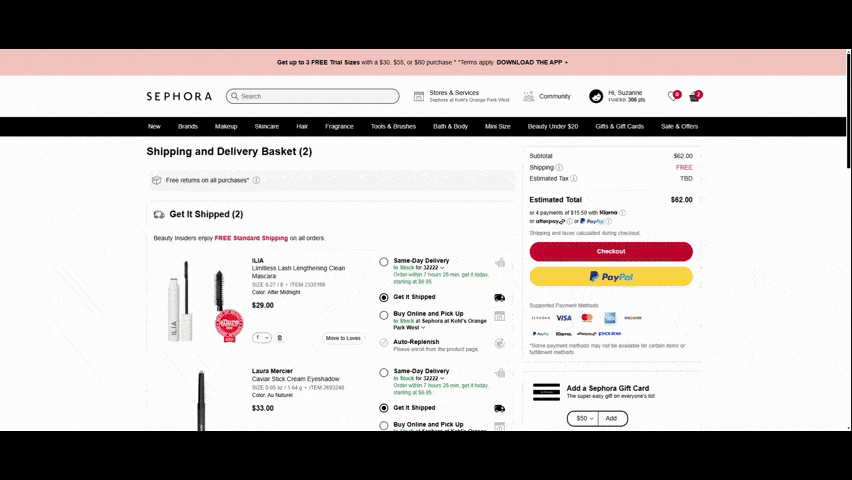
You can see here that the coupon field appears in two spots—on the shopping cart page and in the checkout form. This reduces the need for shoppers who missed it the first time to backtrack.
Also, we see how detailed the error and success messages are.
If the discount can’t be applied, the shopper is given a reason, like the coupon is no longer valid, they didn’t meet the purchase threshold, etc.
If the discount can be applied, there is an “Applied” message beneath the field along with the name of the discount code. The shopper can also delete it if they want to redeem a different code.
All of these details help create a more streamlined redemption process.
With coupon marketing, you can:
You have to be careful though. You don’t want to devalue your brand nor do you want to discount so much that you barely make a profit, if at all.
The key is to find a balance. Offer coupons sparingly and be strategic about what the offers are, who you share them with and how frequently you promote them. If you can strike a good balance, coupons help boost your brand’s ROI over time.
Modern marketing emphasizes long-lasting customer relationships rather than one-time transactions by prioritizing customer experience.
Continue reading...
A recent survey revealed that the top reasons consumers try out or switch brands have to do with the cost of goods or services. A reported 65% said they’d switch retailers for lower costs, and 45% said they’d ditch them for coupons and discounts.
It’s not surprising that decision-making is being driven by cost considering the continually high cost of living these days.
While coupons might be seen as cheapening one’s brand identity, it almost seems like a necessity to offer them in today’s economic climate. In the following post, we’ll look at five best practices for coupon marketing that will help you keep your brand’s value and reputation intact while satisfying consumer needs.
Coupon Design Tips and Best Practices
Here are some things you can do to reap the benefits and profits from coupon marketing:
1. Choose the Best Coupon Format Per Channel
According to the Valpak and PureSpectrum survey referenced earlier, there are five methods that consumers prefer most when receiving coupons and offers:
- 59% prefer emailed discounts
- 49% want to get them in the mail
- 35% like text message-based offers
- 19% enjoy getting them on the company website
- 12% prefer finding them on social media
While this gives us a general idea of consumer preferences channel-wise, it’s always a good idea to test coupon marketing efficacy with your target user base. Not only might they have different channel preferences, they might also prefer coupons delivered in formats you hadn’t expected.
Now, back in the day when it was mostly print marketing, coupons mostly looked the same. We’d see a concise offer like “Buy One, Get One” (or BOGO) and then a scannable barcode that would allow us to redeem the coupon.
But digital coupons aren’t restricted to such a strict or simplistic format. Unless your brand has a brick-and-mortar counterpart where barcodes or QR codes need to be scanned, they’re not an essential element to include when designing coupons.
As you craft your coupon offers and come up with a strategy for where to distribute them, you also need to consider what the best way to design them is.
On a website, for example, there are a number of ways to disseminate coupon codes or offers:
- Display them in the top notification bar
- Announce them via a chatbot in the bottom-right corner of the screen
- Store them in an discount widget in the bottom-left corner of the screen
- Put them in a timed or triggered pop-up
While all are equally viable options, what’s most likely to capture your visitors’ attention at that place and time? What’s more, should you follow a similar design approach to what other websites use or experiment with your own?
For example, Lotus and Luna has a pretty traditional coupon pop-up:

Unlike some pop-ups that make it seem as simple as trading your email for a discount code (which is rarely the case), Lotus and Luna explains that you’re subscribing to a newsletter. This gives you exclusive deals, promos, product drops and other benefits—plus the 20% off the next purchase.
Another approach is a non-traditional one. For instance, Inno Supps has gamified its coupon pop-up.

When a visitor enters the website, this “Supercharged March” pop-up appears, inviting them to “Spin to Win Up to $40.” After clicking the button, the animated wheel spins and reveals which of the discounts or free gift offers they get. To claim the offer, the user must enter their email address.
Would your visitors find it fun to take a spin on the wheel of fortune? Or would they appreciate a more predictable approach to coupon marketing?
This is what you need to figure out as you test different offers, placements and channels in your coupon marketing strategy.
2. Include Pertinent Redemption Details
Your shoppers are probably thrilled when they find out you’re offering a discount. However, coupon marketing isn’t a no-holds-barred sport. Every brand must set limitations or else they put themselves at risk for exploitation.
So, before you hit the “Publish” button on your new coupon or discount offer, figure out what the terms are first. Ask yourself:
- Does the discount apply to everything in the store? Certain categories? Or particular items?
- Is there a limit on how many items the discount will apply to?
- Do customers need to spend a minimum amount in order to claim the offer?
- How long will the coupon be valid for? Or is an expiration date not necessary?
- Is there a limit to how many times the coupon can be used?
- Can the coupon be used in conjunction with other coupons?
- Is there a limit on how many coupons the customer can use per shopping session?
- Can the coupon be redeemed online or in store? If in store, are there only certain stores that will take it?
When publishing the terms of the discount, place them close to the coupon code and offer. Ideally, the terms should be spelled out immediately following the coupon code or call-to-action button. They should also be in a font that’s just as large as the offer text so they’re not missed.
Here’s an example from The Fresh Market. This came via email and was sent to Ultimate Loyalty members:

The customer has a $5 voucher to redeem. Beneath the information on how to get $5 off are the terms of the voucher which include:
- 3/28/25 expiration date
- $5 minimum purchase
- Price valid at customer’s designated store
You can see that there isn’t anything about limiting the number of times the voucher can be used or other terms I mentioned above. In some cases, you don’t need to outline them because you can program your website or app to only accept a coupon or voucher within a certain threshold.
When laying out the terms of the offer, try to keep it as simple as possible so the shopper can focus on their reward. Then, use your CMS to configure the other limits. So long as they’re standard practice (like one-time use), you shouldn’t need to explain it. That said, you may want to add a line about it in your terms of service just to be on the safe side.
3. Determine Who Should Receive the Discount
You probably don’t want to put yourself in a position where users stumble upon your coupon, try to redeem it and then find out that it’s only for “special” customers. There are also reasons why you might not want to give a discount to just anyone.
For starters, a coupon marketing campaign without limits could make your brand seem desperate. Run enough of them and it could also make your brand’s value seem cheap.
What’s more, coupons cut into your profits and can reduce your return on your investment (ROI).
Let’s say in one scenario that you do no segmentation. You share the coupon on social media and your website, and 500 people use it. Over time, you track that user activity and find that only five consumers have returned to your site to buy something else.
Now, let’s say in another scenario you do segmentation and targeting. You only share the discount over email with newsletter subscribers as well as previous customers. 250 people use it. Over time, 100 of them return to your site to buy some more.
While you may have initially gotten more sales from the first scenario, the long-term ROI is very poor. The second scenario is the ideal outcome because it led to repeat business, even though it didn’t net as many upfront purchases.
How you share your offer and with whom is ultimately up to you and your marketing campaign’s goals. Transactional marketing has its time and place, but relationship marketing has proven time and again to be a more profitable strategy.
Here’s an example of how retailers like BJ’s avoid one-time bargain hunters:

Visitors to the BJ’s website are more than welcome to look around the “Deals & Coupons” section of the site. However, they’re not able to clip any of the coupons unless they have an active membership and account. That’s why this login pop-up gets triggered every time they click one of the buttons.
Once the visitor signs in, though, the page changes as do the inactive “Clip to Card” buttons:

What’s really neat about this coupon clipping experience is how simple and streamlined it is. All users have to do is click “Clip to Card” to add the coupon to their membership card.
If they go to the store and buy the items, the coupons automatically apply to their purchase. If they prefer to shop online, they can immediately add the product to their cart as the “Clip to Card” button converts to a red “Add to Cart” or “Shop All Items” button.
One other thing to mention before I finish this point is segmentation. When segmenting your customers, don’t look at it as who deserves a discount and who doesn’t. You can segment your users and then give each of them custom discounts, delivered through different channels and means.
4. Time It Right
It’s definitely possible to overdo it with coupons. When consumers come to see your brand as a “discount brand” (and it’s not), it can:
- Tarnish your reputation.
- Make your products or services feel cheap (not in the good way).
- Have people feeling like it’s OK to dump you when they find a better bargain.
So, coupons should be used sparingly and strategically.
But when and how frequently should you run coupon marketing campaigns? It depends on what kind of business you run.
You could offer coupons and discounts to reward loyal customers at certain points throughout the year. This is an effective strategy as it reminds customers that you’re their go-to source for whatever it is you sell and encourages them to reengage with your brand at regular intervals.
You could also issue coupons to get rid of stock that’s about to be outdated or is nearing the end of its shelf life. By heavily discounting your goods, you’ll appeal to first-time shoppers who may need a bigger push to buy. At the same time, you’ll make way for new inventory that gets customers excited all over again about buying from you.
You can also do coupon marketing seasonally. For instance, if you sell winter gear or summer wear, you could use coupons to push a bunch of new traffic to your store months before.
For example, Soma is doing this right now with its rewards members:

What’s nice about the way this coupon is handled is that it’s a bonus for rewards members.
There’s already a spring sale going on on the website for everyone. But this unique coupon code is sent only to registered Soma members. So, in addition to getting 25% off on their website purchases, they can layer this $10 discount on top of it.
5. Make It Easy to Redeem the Digital Discount
In-store coupon redemption is pretty straightforward. The customer either brings you a digital or printed code to scan or the coupons are automatically deducted from their membership card at checkout.
Digital coupon redemption is a different story. It can be done in many ways. Once you’ve determined what your coupon campaign will entail, you need to map out what this process will look like.
These are the most common ways in which shoppers redeem their coupons:
- They receive an actual code, copy it and enter it into the coupon field at checkout.
- They click a button that automatically applies the discount code at checkout.
- They log into their account, enable their reward and it’s auto-applied at checkout.
Regardless of whether your coupons are auto-filled, click-triggered or manually entered, you need to create a seamless redemption process and test it for different scenarios.
For example, let’s start with the basics:
How many steps will shoppers need to take to redeem their coupon? Or, rather, how many steps do you think they’ll be OK with taking?
For instance, you could make this process very brief. Say you have a logged-in user. In the top-right corner of the site, it says they have $10 to redeem on their next purchase. They don’t need to do anything but shop your store, head to checkout and then click “APPLY” to add the coupon to their purchase.
However, let’s say you have a pop-up triggered to appear on your website for first-time visitors. It’s promoting a very attractive offer—40% off a first purchase.
What would serve you best while maximizing how many people claim the discount? Giving them the discount code right then and there? Or asking them for an email address or phone number and then sending them the code?
Providing the code in the pop-up is the more streamlined path and may help maximize sales. But what if it’s like we discussed before and a lot of these purchases end up being a one-time thing? Unless you’re urgently trying to clear out inventory, that might not help you achieve your goals.
Sending the code to email or text may be the better option, in that case. Sure, some visitors will be annoyed they can’t just get the discount. And others might be wary about being spammed. However, this could be an effective way to reengage customers who haven’t bought from you in a while. It can also be a good way to weed out bargain hunters and to demonstrate to people with genuine interest how great your goods and customer service are.
Next, you need to make sure that the coupon redemption process is straightforward. Ask yourself, will the user understand what needs to be done to claim their discount? And, if there’s a coupon field at checkout, is it easy to find and interact with?
In addition, look at the technical aspects of the process. For instance:
- Do the coupon codes need to be case-specific (like uppercase, lowercase or mixed case)?
- What happens if a coupon is expired or has already maxed-out its limit?
- What happens if they try to apply multiple discounts? Is this acceptable?
- What will the error message look like?
- What will the success message look like?
- Will they be able to remove the discount if they’d like to?
The coupon redemption process on the Sephora website is a good example of a well-thought-out coupon redemption flow:

You can see here that the coupon field appears in two spots—on the shopping cart page and in the checkout form. This reduces the need for shoppers who missed it the first time to backtrack.
Also, we see how detailed the error and success messages are.
If the discount can’t be applied, the shopper is given a reason, like the coupon is no longer valid, they didn’t meet the purchase threshold, etc.
If the discount can be applied, there is an “Applied” message beneath the field along with the name of the discount code. The shopper can also delete it if they want to redeem a different code.
All of these details help create a more streamlined redemption process.
Wrapping Up
With coupon marketing, you can:
- Attract first-time customers to your brand.
- Lure back inactive customers.
- Incentivize existing customers to make a purchase when they hadn’t planned to.
You have to be careful though. You don’t want to devalue your brand nor do you want to discount so much that you barely make a profit, if at all.
The key is to find a balance. Offer coupons sparingly and be strategic about what the offers are, who you share them with and how frequently you promote them. If you can strike a good balance, coupons help boost your brand’s ROI over time.
Making the Transition from Transactional to Relationship Marketing
Modern marketing emphasizes long-lasting customer relationships rather than one-time transactions by prioritizing customer experience.
Continue reading...
